Mitigating Plugged Chutes
Plugged chutes can be somewhat mitigated with good design, but sensors with automated alerts should be used to monitor, tweak, and ensure material flows smoothly.
April 10, 2023
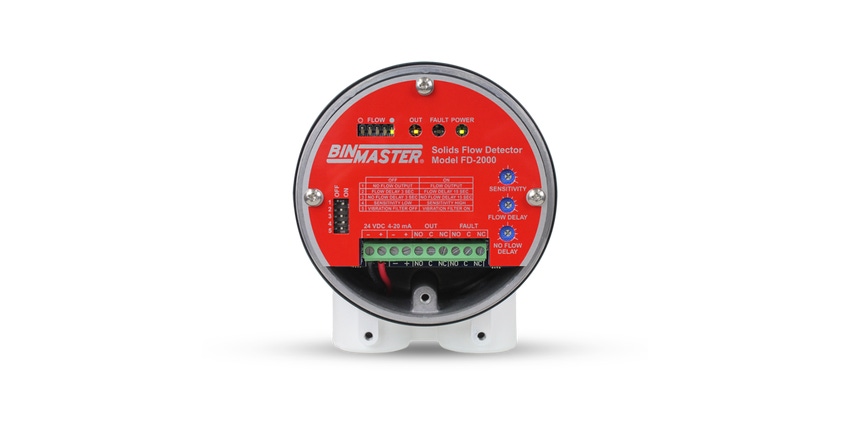
David Zelnio, BinMaster Level Controls
Most operations handling bulk solids experience plugged chutes. It is expensive. A plugged bin or chute cost one facility $50,000 a day in lost production and labor, according to Sukup Manufacturing. In mining, blocked chutes are responsible for about 60% of conveyor-related accidents, according to the Australasian Mine Safety Journal.
Chutes are used to control direction of material, flow stream, spillage, dust and environmental pollution, production degradation, retard or control flow, and surge control (ckit.co.za, 2023).
Cost is a factor for designing a bulk material handling system to accommodate different materials, according to Rich Tavis, instrumentation application specialist.
“I work with a company that purchased an agricultural facility and used it for minerals processing,” Tavis said. “They don’t want to invest in new silos, conveyors, and chutes, so they adapt and utilize sensors to monitor bulk material flow.”
High-tech sensors indicate flow and no-flow material conditions to alert operators before--or shortly after--a plug occurs.
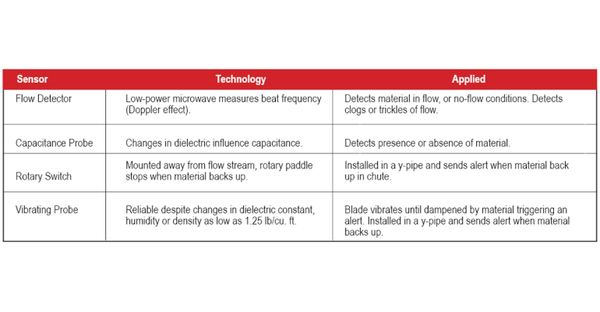
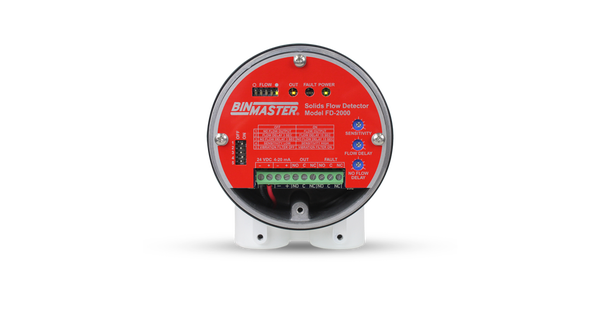
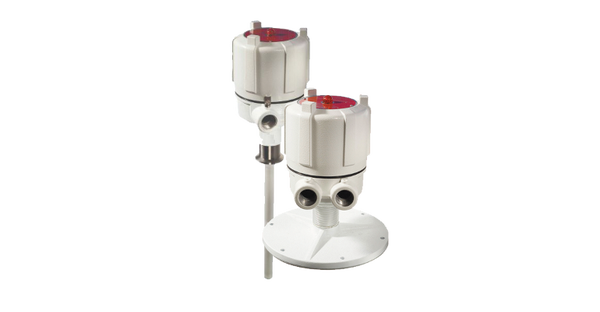


Years of Sensor Experience
Everything varies: silo height, material density, conveyor size and speed. The best way to configure sensors and software for chutes is to lean on experience. Tavis, for example, has configured systems for more than 20 years.
“Often, cement plants use kilns that have massive ‘walking floors.’ They are basically metal belts that carry fuel through a long tunnel that looks like the ‘flames of hell.’ Cool to see, but I wouldn’t want to visit,” Tavis said. “They burned wood, tires, and other waste materials as fuel. It’s an environmentally friendly way to avoid more landfill.” Tavis said sensors helped monitor a chute that carries ash to the end of the process. Un-burnt chunks could cause problems and plug the chute at the end of the belt.
The Science of Chutes
Engineered material flow is an intentional plan of how materials will move through a process. It requires an understanding of every moment bulk material moves through a facility. Studying the science of chutes can prevent problems. Looking at bulk material through the lens of engineered flow, an operation can see benefits with reduced dust, plugging, buildup, and load impact. Degradation of materials also lessens as load control is improved (bulk-online.com, n.d.).
The keys are speed, direction of flow, and material characteristics. As chutes are designed, consideration should be paid to the way material steers through changing surfaces, as well as the material’s friction values. Special consideration should be given to materials that are hygroscopic. Tweaking surfaces can help minimize dust and relieve a center load. The goal in most material is “fluid-like” flow versus clumps bouncing off each other like billiard balls (hubspot.net).
Chutes should account for capacity, conveying distance, product distribution, and abrasion resistance of chute materials (ckit.co.za).
Another factor is continuity of flow, which can be measured with a relatively inexpensive test of friction coefficients and adhesion. Friction between material and the chute is not constant. It increases with reduced depth of flow in the chute and other changes in moisture.
Putting it All Together
Plugged chutes can be somewhat mitigated with good design, but like every bulk material process, sensors with automated alerts should always be used to monitor, tweak, and ultimately to ensure that material flows as smooth as sand through an hourglass.
Chute Design Problems
• Traditionally-designed with box shape to avoid fabrication expense
• Designed based on angle of repose and are prone to blockage
• Flow and downward energy of material causes wear on metal walls
• Material moves causing extra dust
• Two conveyors running simultaneously cause material velocity to increase and belts to become overloaded.
• Plugged or blocked chutes create spillage when a belt restarts
• A conveyor system should be designed to handle when a system shuts down. Under normal stops, chutes should not plug. This might be accomplished by stopping the system sequentially starting with the most upstream belt, allowing each step to purge itself of materials before stopping.
• 90% of mining dust is caused by storage and transfer of bulk solids (pure.unileoben,ac.at)
Chute Safety Scenarios
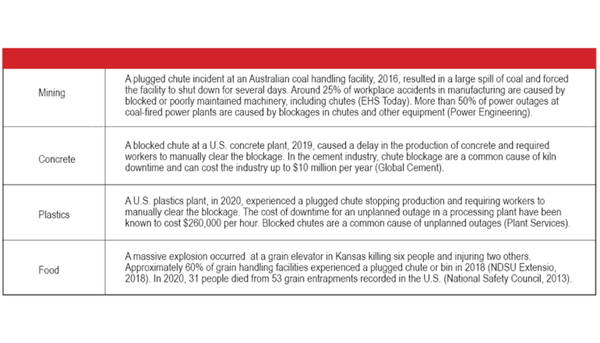
David Zelnio is marketing communications manager, BinMaster Level Controls (Lincoln, NE). For more information, call 402-434-9102 or visit www.binmaster.com.
References
22 engineered flow chutes - f.hubspotusercontent20.net. (n.d.). Retrieved March 23, 2023 from https://f.hubspotusercontent20.net/hubfs/5156573/MartinEng_F4_Ch22.pdf
Agrawal, R. & Kazi, F. (2019). Analyzing the Causes and Effects of Material Blockage in Chute Systems. Journal of Failure Analysis and Prevention, 19, 1663-1675
Australasian Mine Safety Journal. (2016). Handling blocked chutes and transfer points. https://www.amsj.com.au/handling-blocked-chutes-and-transfer-points
EHS Today (2019). Top 10 OSHA Violations in Manufacturing Industry: https://www.ehstoday.com/safety/top-10-osha-violations-manufacturing-industry
Flow of bulk solids in chute design. (n.d.). Retrieved March 23, 2023, from http://www.ckit.co.za/secure/conveyor/papers/bionic-research-1/c-bri1-paper02.htm
Global Cement (2015). Material handling: Chute blockages cost cement industry millions: https://www.globalcement.com/news/item/3489-material-handling-chute-blockages-cost-cement-industry-millions
Iowa State University Extension and Outreach (2018). Safety Tips for Grain Handling Facilities. Retrieved from https://www.extension.iastate.edu/ag/safety-tips-grain-handling-facilities
Kramer, J. & Walters, J. (2015). Solving Material Handling Problems: Foreign Objects. Powder and Bulk Engineering, 29, 18-22.
McCarthy, B. (2019). Preventing Material Buildup in Bins, Silos, and Hoppers. Chemical Engineering Progress, 115, 40-45.
National Safety Council (2013). Grain Handling Safety. Retrieved from https://www.nsc.org/home-safety/tools-resources/seasonal-safety/summer/grain-handling
NDSU Extension (2018). Reducing Grain Handling Accidents and Injuries. Retrieved from https://www.ag.ndsu.edu/publications/crops/reducing-grain-handling-accidents-and-injuries
Plant Services (2019). The true cost of unplanned downtime: https://www.plantservices.com/articles/2019/the-true-cost-of-unplanned-downtime
Power Engineering (2019). Power Plant Pumps: Guidelines for Application and Operation to Maximize Uptime, Availability, and Reliability: https://www.power-eng.com/2019/06/17/power-plant-pumps-guidelines-for-application-and-operation-to-maximize-uptime-availability-and-reliability
Pure.unileoben.ac.at. (n.d.). Retrieved March 23, 2023 from https://pure.unileoben.ac.at/portal/files/2469720/AC08164424n01vt.pdf
Schmidt, J. (2017). Understanding Chute and Feeder Maintenance. Mining Engineering, 69, 26-29.
Sukup Manufacturing Co. (n.d.). Managing Bin and Silo Choking. Retrieved from https://www.sukup.com/products/bin-technology/managing-bin-and-silo-choking
Thread: Flow of bulk solids through transfer chutes of variable geometry and profile (A.W.... bulkonline Forums RSS (n.d.). Retrieved March 23, 2023 from https://forum.bulk-online.com/showthread.php?29591-Flow-of-Bulk-Solids-Through-Transfer-Chutes-of-Variable-Geometry-and-Profile-%28A-W
Tylczak, J., Wypych, P., & Łuczak, J. (2018). Analysis of the Influence of Selected Parameters on the Material Flow in a Gravity Chute. Archives of Civil and Mechanical Engineering, 18, 799-808.
You May Also Like


